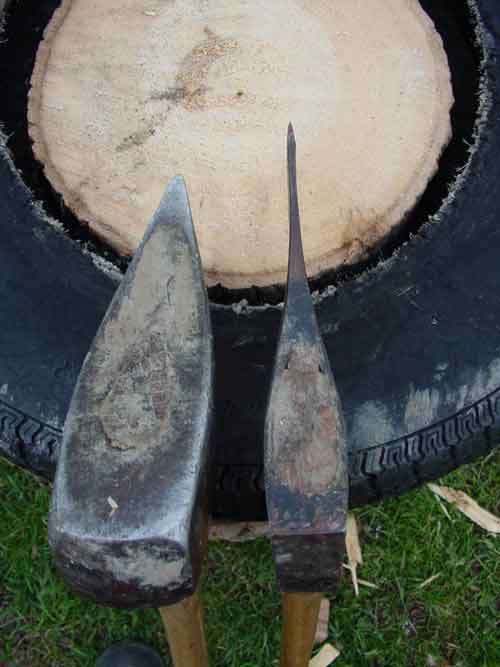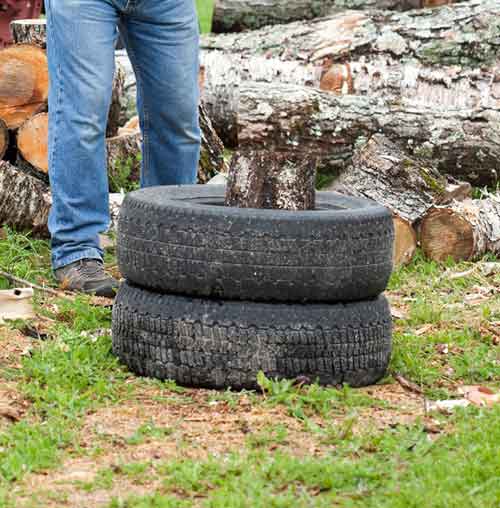 If you live in the country, you may already know about keeping a woodpile stocked. But even many city neighbourhoods are more like forest villages than concrete jungles. These places, too, are great sources of economical home heating fuel, even if only in small quantities. Although I live in the country now, I grew up in suburbia, yet always with a few logs in the yard gleaned from neighbours and hauled home in my parents’ station wagon for cutting, splitting and burning in our basement fireplace. Even as a teenager, the whole firewood thing was a kind of mediative experience for me. Now more than ever, preparing firewood is still a great way to introduce kids to the value of productive outdoor labour.
If you live in the country, you may already know about keeping a woodpile stocked. But even many city neighbourhoods are more like forest villages than concrete jungles. These places, too, are great sources of economical home heating fuel, even if only in small quantities. Although I live in the country now, I grew up in suburbia, yet always with a few logs in the yard gleaned from neighbours and hauled home in my parents’ station wagon for cutting, splitting and burning in our basement fireplace. Even as a teenager, the whole firewood thing was a kind of mediative experience for me. Now more than ever, preparing firewood is still a great way to introduce kids to the value of productive outdoor labour.
It’s early June right now, and my son and I just finished cutting, splitting and stacking most of the wood we’ll need for the coming winter. We have good times working together on our log pile each year and it’s the kind of work more people would benefit from.
Wherever trees die, break off in the wind, or outgrow their allotted space, you’ll find the potential for firewood. I say potential, because having trees (or friendly neighbours that do) is just the first and easiest part of the operation. Making that wood conveniently and effectively burnable in a wood stove or fireplace comes next. Sounds like work, and that’s because it is. Hard work. But as usual, there are two ways to look at the job: It’s either drudgery you should avoid by stocking up on artificial wax fire logs, or a fitness regime that also warms your house during winter. When it comes to making firewood, I see the glass as half full.
Splitting Firewood
Sawing logs into lengths to fit your fireplace or woodstove is the easy part. A chainsaw makes that so. The challenging part of making firewood is the splitting — cleaving sawn logs along the grain lengthwise. Why bother splitting? Two reasons. First, most logs are too big to fit comfortably in a wood stove or fireplace. Splitting is the best way to make them thinner. And second, even if a particular log isn’t too big, split wood burns better because it dries more thoroughly without a continuous wrapper of bark.

The splitting axe is the quintessential blunt instrument, one for which there’s no substitute. Don’t even try to split firewood using a regular axe. The shape is just too thin. Splitting axes don’t have to be sharp, but they do need to be heavy (6 lbs. to 8 lbs.) and bluntly angled in cross-section. This angle is what drives the log apart and stops the axe from sticking in the wood uselessly. The axe you see on the left of the photo is a wonderfully effective splitting axe. It’s been with me for 35 years, it’s been fitted with more than a dozen handles over the years and we’ve split hundreds of cords of wood together. The axe on the right is for cutting down trees. It works great for that job, but it’s useless for splitting. Note how thin it is compared to the splitting axe.
A Safer Way to Split

But there’s another problem with splitting firewood, a hitch that the best splitting axe won’t cure. How do you hold up the wood on it’s end before hitting it? All the firewood I split with an axe goes through the car tire arrangement you see here. The tires are bolted together through the sidewalls in three places, forming the ideal holder for all but the largest logs. Just drop the wood in on-end, then bang-away with your axe as many times as needed to split the pieces. You never have to bend down and stand another log up before hitting it again because nothing falls over. Another bonus is the way the sidewalls act as a cushion for the ax handle, keeping the blade from hitting the ground, without need for a chopping block.
Got a Loose Axe Handle? Try This
Got a loose axe handle? Try Chair Doctor. It’s a thin, white liquid adhesive made only by Lee Valley Tools. I’ve never found anything else like it on the market, so I’m mentioning it specifically. Chair Doctor is almost as thin as milk, so it wicks into the end of any wooden handle, swelling the wood and locking it within the axe head. It’s a great way to make a loose handle tight.












